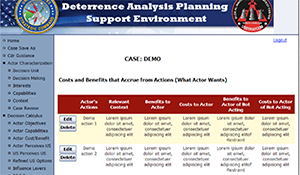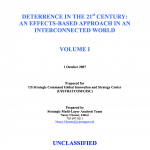Deterrence in the 21st Century: Volume I

Deterrence in the 21st Century: An Effects-Based Approach in an Interconnected World Volume I.
Author | Editor: Chesser, N. (DTI).
This report summarizes the results from a 120-day effort that was undertaken to meet these challenges. A scope of the effort is provided by Lt Col Shannahan in section 1; namely, decision makers, policy makers and commanders at all levels need to better understand deterrence theory applicable to the 21st century security environment. The USG requires a typology to understand the ways and means to deter a non-nation-state actor while simultaneously retaining the means to deter and compel nation-states.
The effort focused on the scientific underpinnings of deterrence. A broad viewpoint was adopted; namely actions that prevent an adversary from engaging in behaviors that threaten or oppose US national interests. For further elaborations please refer to the Glossary (Appendix B).
The effort, instead of focusing on an adversary’s capability as the basis for planning, refocuses analysis and planning on the actor’s motivations for action, his intent, and the structure of his decision problem as he sees it. Capability is not ignored, but actor’s perspective, motive and intent is at the core of this effort and the role of social science is paramount. The results are actualized in the Deterrence Analysis and Planning Support Environment (DAPSE) which is a web application that captures the depth of current academic thought along with established military doctrine to advise planners and associated staff with the means to deter the adversary. A DAPSE overview and description are provided in sections 2 and 3 by Dr Chesser and Stu Schwark & Altaf Bahora respectively.
A primary task of the Deterrence Strategic Multi-layer Analysis (SMA) project was developing a typology that could characterize the information needed for understanding adversaries and other actors of interest. A typology was developed that is consistent with various social science disciplines, and that incorporates a thorough consideration of human and cultural factors necessary for understanding what people value and how to influence them; i.e., a systems hierarchical paradigm for analyzing any society. The systems hierarchical approach is based on several anthropological ontologies that relate the various aspects of society, and is also based on inputs from the numerous social scientists involved in this project. Key aspects of a society captured in the systems hierarchical approach include ideology and religion, culturally based values, social organization, culturally prescribed roles, demography, and the actor’s decision making process, as well as capabilities.
These are described by Dr Larry Kuznar in section 4. While the DAPSE typology is one of the more complete and useful typologies for guiding analysis and planning, there are gaps. Two of the most obvious are a lack of consideration of language and history.
Drs Laurie Fenstermacher and Bob Popp discuss the role of modeling in section 5. Models, first and foremost, augment the ability of an analyst or planner, but do not in any way replace them. Models aren’t turnkey… they provide input to decisions, they don’t make them! They are good at producing a swath of forecasts (e.g., the range of probable locations for landfall of a hurricane), not good at producing point predictions (due to inherent uncertainty in the data or in the model itself). In addition, models can compensate for limits in subject matter expert (SME) knowledge. Due to the inherent complexity and dynamic nature of the systems and problems of interest, it is extremely difficult for an expert, or group of experts, to account for the effects of all possible interactions, particularly those with a low probability of occurrence. A complete reliance on SMEs will result in a very subjective assessment devoid of empirical evidence!
Section 6 by Dr Allison Astorino-Courtois outlines the use of the DAPSE Typology to guide the user’s information search and organization; “reconstruction” of the interest-based decision calculus from the deteree’s perspective; and techniques for analyzing that decision calculus to discover the most effective “influence levers” for deterring an opponent’s unacceptable activities. This is at the core of this deterrence effort and the reader is well advised to dwell on it.
Having identified the strategic context, deterrence objectives and decision calculus of actor(s) to be deterred, the analysis now turns to analyzing the truthfulness of the hypotheses (influence levers) emerging from the decision deterrent matrix, and also evaluating possible courses of action and their consequences under different conditions. These approaches are described in section 7 by Drs Bob Popp and Laurie Fenstermacher.
The final stage in the DAPSE process is a last check of the refined US deterrence option(s) identified and evaluated and tested. To do this the refined US deterrence option, now including actual US DIME (Diplomatic, Informational, Military, and Economic) actions, is “run” back through the Deterrence Decision Calculus (DDC) matrix. This is described in section 8 by Dr Allison Astorino-Courtois.
By now the reader should be aware that the approach taken focuses on the actor’s intent instead of focusing primarily on adversary capability…a necessary change after a near monopoly on capability fixation in the Cold War. This shift is the holy grail of the intel community and an essential maxim of our new world order – the shift from physical space to cognitive space. This necessitates the need to expand use of non-traditional sources of information and application of non-traditional analyses (e.g., cognitive and behavioral modeling). These are described in section 9 by Drs Bert Davis and Brian Meadows.
In section 10, LCDR Wes Latchford discusses perspectives on deterrence provided by the private sector. In support of the SMA, the GISC Partnership Group was asked to leverage its unique network of non-traditional domestic and international civilian business and academia experts to explore how particular elements of private sector enterprises approach the concept of “deterrence,” the indicators utilized to determine when deterrence is necessary, and the “ways and means” by which deterrence is accomplished. The private sector provides a “Second Set of Eyes” perspective outside of DoD.
In section 11, Dr Carl Hunt and CAPT(S) Todd Veazie address the very important topic of networks and connections in developing a deterrence strategy. Their theme is that deterrence in the Cyber Age will not work as it did in the Cold War, simply because we will find it far more difficult to apply it and to understand feedback from its use – we may not be able to understand what the adversary values and thus never understand how to place that value at risk. This will absolutely require more consistent use of multi-disciplinary thinking and decision-making. We must create a Cyber Power-based DIME incorporating interconnectivity and economic interdependencies already emerging: we must change thinking about the DIME to include interconnectivity and shore up the economic, diplomatic and information components, while strengthening the potential of the military component.
Each of the sections in this report identifies, as appropriate, areas that need further work. In section 12, Dr Larry Kuznar identifies several key areas that clearly require more development. They include social neuroscience, global challenges, information age deterrence and strategic communication, and dynamism and complexity. Related to these is the potential for the development of a dynamic approach to deterrence that would incorporate feedback from on- going US COAs (courses of action) and re-evaluation of deterrence strategies, operations and tactics.
Having developed the methodology and a set of procedures, the effort turned next to several potential notional scenarios to assess whether or not they worked together to produce a viable result. In section 13, Dr Sue Numrich, explores one of the test scenarios in some depth. The scenario selected is based on a current problem – the influx of foreign fighters into Iraq. Although the DAPSE process is intended to be exercised over a longer time period, the analysts who developed this scenario worked over a period of only four days relying on their accumulated experience. The section summarizes a set of possible deterrence options based on this analysis.
Products resulting from efforts like this with heavy reliance on social science can atrophy rather fast. Col Tim Fay in section 14 discusses transition options being contemplated.
As the effort neared completion, the team applied the DAPSE to several NOTIONAL scenarios primarily to identify and rectify gaps/deficiencies. These are being published separately. The first three are classified and will be forwarded in appropriate channels:
- Scenario 1: Non-state
- Scenario 2: State – PACOM
- Scenario 3: State – CENTCOM
- Scenario 4: Sudan (multiple actors)
Many thanks are due to all who worked on this effort (see Appendix F), to the contributors to this report and finally to Dr. Nancy Chesser who patiently edited the report.

Comments